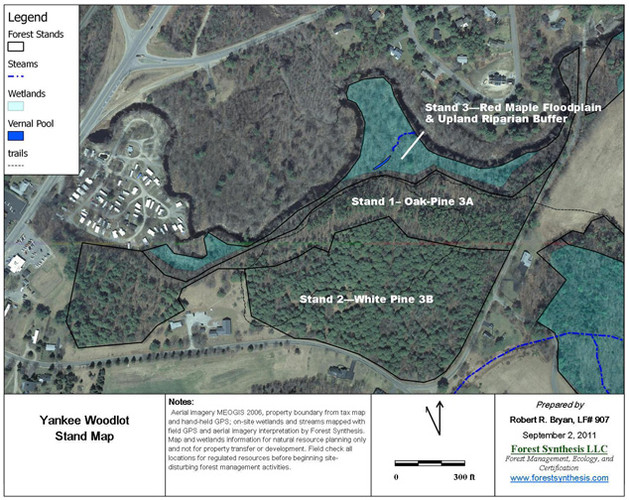Yankee Woodlot Timber Harvest
Project Goal
The Yankee Woodlot is a 34-acre demonstration site where visitors enjoy a New England forest and learn how managed woodlands can promote both wildlife habitat and healthy trees.
Project Theme
A managed forest can be a healthy forest for wildlife, recreation, and timber.
Related Information
Objectives for the Yankee Woodlot are in keeping with the 2011 report Forest Habitat Assessment and Management Recommendations, prepared by Forest Synthesis LLC for the Reserve and available to download from the Stewardship section.
Management Objective
The forest is generally young (30-60 years old) and uniform. The long-term objective is to develop a more mature forest of varied structure interspersed with patches of young-forest habitat. A light partial harvest will be used in most of the woodlot to promote forest regeneration, healthy trees with good growth potential, and trees with high value for wildlife. The cut will also include the creation of a ½-acre patch cut that will be allowed to revert to forest over time, and another 1- to 2-acre patch cut that will serve as a wildlife opening, which could be maintained or allowed to revert to forest over time. Within the harvest areas, roughly 1/3 of the volume of timber will be harvested. Options for downed trees/limbs may include biomass removal and/or creation of brush piles.
Specific Management Goals
- Diversify age class structure in Stands 1 and 2 consistent with Focus Species management goals: 1) Create patches of younger forest habitat, and 2) Target areas in Stands 1 and 2 more suitable for developing mature forest structure.
- Conserve riparian, floodplain, and vernal pool habitats (Stand 3).
- Control invasive plants.
- Improve timber quality and health in Stands 1 and 2 for long-term growth and harvest of forest products.
Additional Goals
- Promote the Yankee Woodlot as an educational resource for southern Maine landowners and visitors to the Wells Reserve.
- Create a visual management zone along the public roads that enhances views into the forest and includes a diversity of overstory and understory structure, while promoting a maturing, well-stocked overstory.
- Create a historic site management zone around the old foundation where site enhancement and historic interpretation are the primary objectives. A mature forest canopy will be promoted and a more open understory maintained than in areas where forest regeneration and understory wildlife habitat are primary goals.
Special Considerations
- Shoreland zone/invasive plant management: The floodplain and the steep bank will be left undisturbed with the exception of invasive species removal. Encouraging native ecosystem restoration will be a goal through invasive plant management or removal.
- Historic Site Zone: An intact 200-year-old farmhouse-and-barn foundation exists on the property (with a large, old maple tree that may have been planted when the home was last occupied). An interpretive sign is located at the site. This heritage area (about 2 acres) will be managed with its preservation and enhancement in mind.
- Visual Management Zone: This will be incorporated along the roadways (the approaches to the Wells Reserve). The management here will range from selective cutting to no cutting, with the goal of enhancing the visual appeal of the forest for passersby.
- Deed Restrictions: This property was donated to the Reserve. This activity is in keeping with the donor’s wishes for the property to be forever part of the Reserve and to “provide habitat for a variety of wildlife” and for the grantee to be free to “establish nature trails and maintain good forestry procedures in relationship to the standing timber.”
Education Goals
Through a series of workshops, the timber cut and shoreland protection areas are being used to educate landowners about how they can manage their own property for timber, wildlife, and (if appropriate) recreation. The cut and workshops, the first phase of this project, were held in late summer and early fall 2012.
The long-term education goal is to incorporate the Yankee Woodlot into ongoing interpretive education programs. The timber cut will take this, and an existing ¾-mile trail loop, into consideration.
This project also offers opportunities for long-term monitoring of ecological change.
Elements to be considered for educational materials include:
- Single-cohort structure; minimal understory
- Old plow ridge and hedgerow in Stand 1 (eastern section)
- Flat soil surface (no pit and mound undulations)
- White pine density and impacts of the pine weevil
- Old house site
- Earliest possible USDA imagery
- Tree ring counts to confirm stand establishment period
Workshops will demonstrate:
- Habitat and focus-species-based management planning
- Invasive species identification and control methods
- Harvesting to improve timber quality
- Habitat improvement techniques, such as snag retention and felling some trees for large woody debris
- Harvesting to improve habitat diversity
- Tree planting to improve long-term stand diversity and adaptation to climate change
- Impacts of browsing by installing a deer exclosure
- Develop access to and information on wetland, riparian, and vernal pool habitats
- Natural process of understory re-initiation
- Long-term stand development and late successional structure
- Determining fire history


